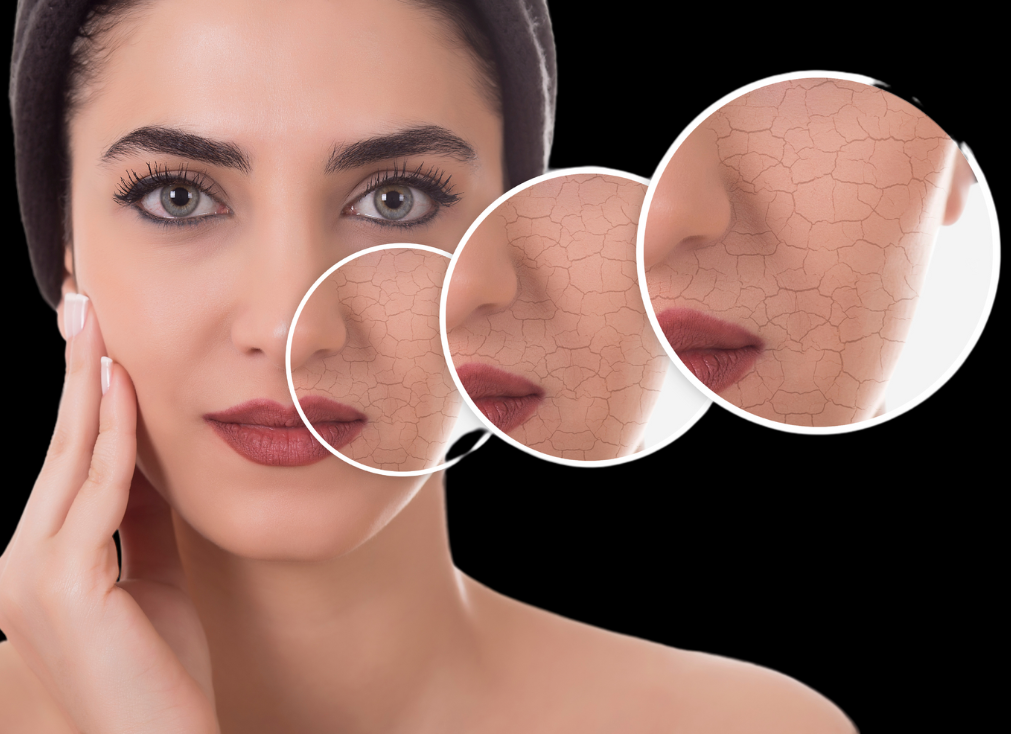
“85% of the world population can be classified as having “sensitive skin” identified by redness, irritation, and broken capillaries.“
- Roxanne Valinoti

Summer Skin Care Guide
As the seasons change, so should our skincare routine, and the summer months call for a “less is best” approach. On the East Coast, especially Long Island, long, hot days come with high humidity, so simplifying your skincare routine is recommended. Additionally, since the sun is at its strongest, it’s also important to protect your skin, especially on the face and neck, where signs of aging can be more noticeable. Follow the Three P’s for healthy, glowing summer skin ~PREPARE. PREVENT. PROTECT.
1. PREVENT
Proper preparation prevents problems, and as the old saying goes, “You are what you eat,” so choose local summer produce to nourish your body and promote glowing skin. Not to mention other benefits like reduced inflammation, improved cardiovascular health, and cognitive function.
UV Radiation from the sun is a significant source of free radicals. Free radicals are unstable molecules that cause oxidative stress and cellular damage to the body, leading to a host of health issues in the body, including premature aging. Antioxidants are compounds that protect our cells from free radicals by stabilizing them, thus reducing their potential to react with other molecules. To combat free radicals, we must add antioxidants to the diet (and skin care, too!)
Some of the best seasonal whole foods rich in antioxidants are:
Berries- especially blueberries, which have Anthocyanin, a powerful polyphenol antioxidant
Cherries – fresh is best as some antioxidants can diminish when frozen
Figs- the darker the fig, the more antioxidants
Watermelon- is excellent for hydration, too!
Broccoli- High in vitamin C, a very effective antioxidant alone but even better with vitamin E
Tomatoes- rich in lycopene, a powerful antioxidant to help prevent UV damage
Kale- extremely high in Vitamin A
Peppers- high in carotenoids, which have been shown to decrease sensitivity to the sun
Walnuts -an excellent source of Omega-3 fat AND Vitamin E
2. PREPARE
Just as we swap out our winter wardrobe for lighter options, we should do the same to our skincare routine. Summer is all about simplicity, so put away the scrubs, oils, and heavy moisturizers and stick to a simple three-step approach morning and night.
Cleanse—SPF, sweat, salt water, chlorine, etc., are tough on the skin in the summertime. Be sure to double cleanse with a cleansing oil first to remove sunscreen, makeup dirt, and pollution from the day, followed by a gentle cleanser suited for your skin type. Ditch the harsh makeup remover wipes and use a clean, soft washcloth.
TRY: Eminence Stone Crop Cleansing Oil & Lemon Cleanser
Nourish—Lightweight serums are a great way to add extra hydration and antioxidants to the skin to combat the effects of the sun. Opt for Vitamin C, a powerful antioxidant that brightens and lightens skin. Press (don’t rub) serums into damp skin with fingers for maximum absorption.
TRY:
Eminence Stone Crop Hydrating Mist for a boost of hydration
Eminence Citrus & Kale Potent C & E Serum—This serum’s potent Vitamin C is stabilized by botanically-derived ferulic acid, delivering antioxidants to help brighten skin, improve the appearance of fine lines and wrinkles, and reduce the appearance of free radical damage.
Moisturize—The skin barrier can weaken when exposed to excessive sun exposure, so be sure to keep it protected from external stressors. Always moisturize your skin after exposure to salt, sun, or sand to rehydrate and balance the skin from the dehydrating effects of the elements. Change out heavy moisturizers for a lightweight formula based on your skin type and condition. For a lighter application during the day, emulsify a small amount of moisturizer in your hand with a few drops of water.
TRY: Eminence Bright Skin Moisturizer SPF 40 for added sun protection
Stone Crop Whip Moisturizer
3. PROTECT
Spending time outdoors and getting some rays certainly has its benefits, like getting a daily dose of Vitamin D, stress reduction, and even regulating our sleep cycle. However, if you’re going to be spending prolonged hours in the sun, protection is vital to avoid damaging your skin, which is linked to premature aging, wrinkles, and pigmentation. A few things to consider when choosing sun protection:
“Broad Spectrum”— UV reaches the skin in three different forms: UV-A, UV-B & UV-C. UV-A ( known as aging rays) is a deeper penetrating form of UV that weakens the collagen and elastin fibers, hence the leading cause of aging and wrinkles. UV-B (known as burning rays) is the primary cause of sunburn, and while it’s not as penetrating as UV-A, it’s actually stronger and more damaging to the skin and eyes. However, it’s also the main contributor to the synthesis of Vitamin D. UV-C never reaches us, as the planet’s ozone layer absorbs it. This explains why it’s so essential to have broad-spectrum protection, as this term is used on products that protect from both UV-A and UV-B rays.
“SPF” (Sun Protection Factor)—measures how well a product will protect from UVB rays only. According to the FDA, SPF 15 is the minimum you should wear to prevent skin cancer, while the European and American Academy of Dermatology both recommend 30 or higher, which blocks nearly 97% of UVB radiation, while SPF 50 blocks an estimated 98%.
“Water Resistant”—For a sunscreen to claim it is water resistant, it must be tested for SPF after the tester has spent 40 minutes in a pool or hot tub. Even if you’re not spending time in the water, it can combat sweat and high humidity levels, so water resistance is a good option, but remember to reapply frequently.
“Chemical” Vs. “Mineral”- There are two formulations of sunscreens to choose from. The more favorable is mineral sunscreen, which utilizes ingredients like Zinc Oxide and Titanium Dioxide that sit on the surface of the skin and physically block or prevent the majority of rays from penetrating the skin. Both Zinc Oxide and Titanium Dioxide are deemed “safe ” by the FDA. However, these can be heavier on the skin, although newer mineral options have come a long way. Higher quality brands go smooth and no longer leave a white cast on the skin.
By comparison, chemical sunscreen formulas allow UV light into the skin. Once the light is absorbed into the skin, the chemicals in the sunscreen create a chemical reaction in which UV light is converted to heat, and the heat dissipates from the skin. Chemical sunscreens have been statistically shown to perform better on how long they protect the skin. However, these chemicals (oxybenzone, avobenzone, octisalate, octocrylene, homosalate, and octinoxate) have been found to penetrate the skin into the bloodstream. The EWG ( Environmental Working Group) recommends avoiding chemical sunscreens with oxybenzone because of concerns that this ingredient may disrupt hormones, cause allergic skin reactions, and cause damage to the ocean and coral reefs. Whichever option you choose, be sure to apply your sunscreen at least 15 minutes BEFORE sun exposure, as it will allow some time to penetrate the skin and create the protection shield. ALWAYS wash your face in the evening after wearing sunscreen during the day.
Choosing and wearing sunscreen is a personal choice, but there are other methods of protection, too. Bring an umbrella to the beach, wear a hat, sun visor, or sunglasses, or consider clothing with a UPF ( Ultraviolet Protection Factor) to protect from harmful UVA rays.
Stop in to the spa for more information, samples, or to book a consultation to find out what’s best for your skin condition and lifestyle. Enjoy the Summer!
Sponsored Links
About the Author

Roxanne Valinoti
Roxanne Valinoti is a highly accomplished licensed Nail and Skin Care Professional with over 25 years of experience in the beauty industry. As a Certified Holistic Health Coach, her approach to each service is customized to individual client goals, and believes in partnering with clients for long-term results.







